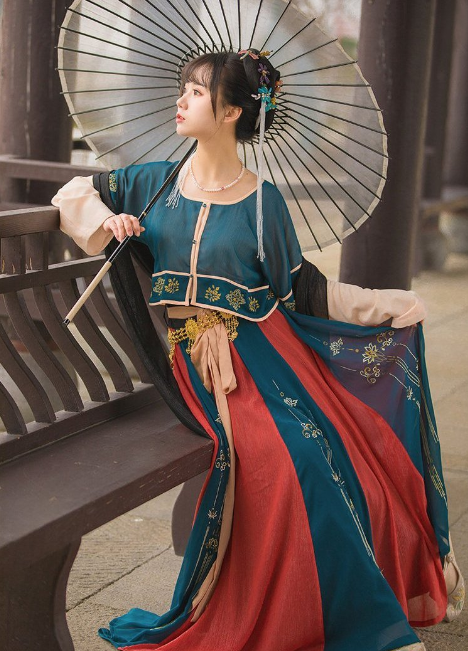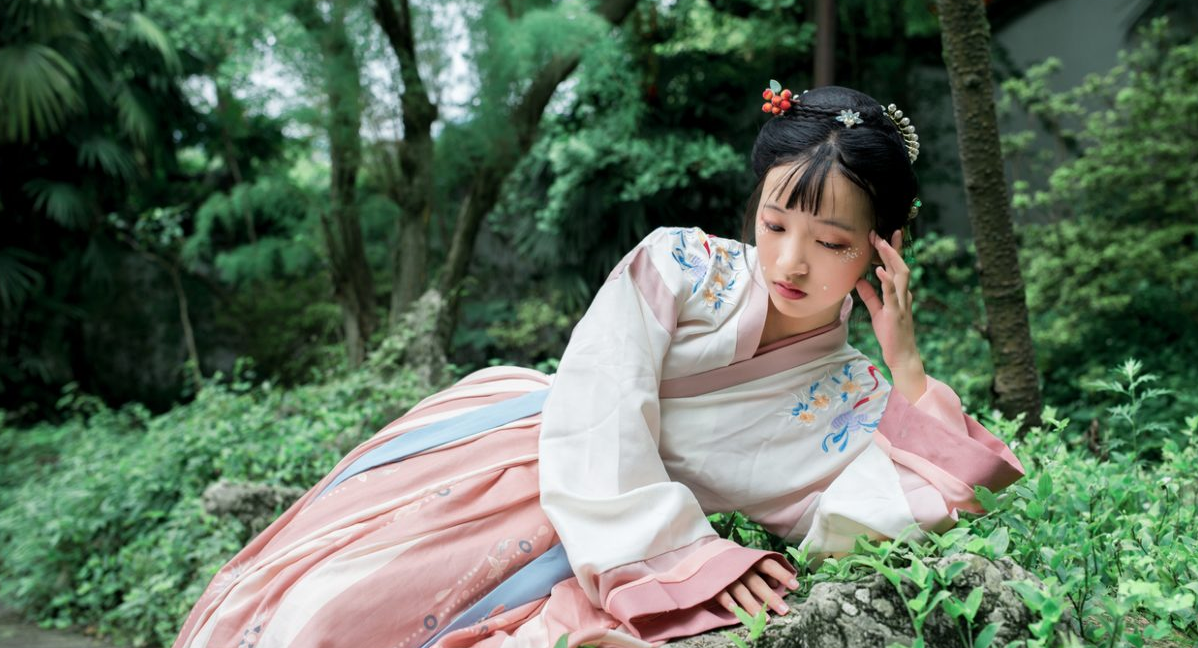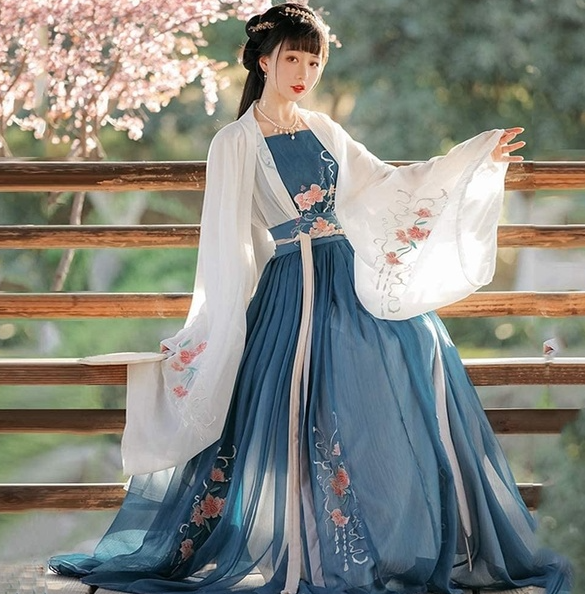Hanfu symbolizes Chinese cultural heritage, serving as a visual representation of ethnic identity, traditional values, and social norms.
Cultural Significance
Hanfu as an Ethnic Identity
Hanfu is not just a type of traditional Chinese clothing but also serves as a strong symbol of ethnic identity for Han Chinese. This style of dress traces back thousands of years and is deeply rooted in China’s history and tradition. For many Han Chinese, wearing Hanfu isn’t just a fashion statement; it’s an expression of cultural and ethnic pride. Various aspects of the Hanfu, such as the colors, patterns, and embroidery, often reflect the geographical and social background of the wearer. In recent years, there’s been a resurgence in the popularity of Hanfu, especially among young people who see it as a way to connect with their heritage.

Hanfu in Cultural Rituals
In traditional Chinese society, Hanfu was often worn during various rituals and ceremonies, such as weddings, funerals, and ancestral worship. Different types of Hanfu were designated for different occasions, and wearing the wrong type could be considered a social faux pas. For example, bright and ornate Hanfu are often associated with festive occasions like the Lunar New Year or weddings, while simpler, muted designs are used for somber events like funerals. Hanfu, in this context, serves as a form of non-verbal communication, signaling the purpose and significance of the gathering.
Philosophical Underpinnings in Confucianism, Daoism, and Buddhism
Hanfu is deeply tied to various philosophical teachings in Chinese culture, particularly Confucianism, Daoism, and Buddhism. Confucian principles emphasize propriety and ritual, which are reflected in the traditional codes regarding how and when to wear Hanfu. Daoism’s influence can be seen in the simple, flowing designs, which reflect a desire for harmony with nature. In Buddhist contexts, Hanfu often incorporates specific symbols like the lotus flower, which is a symbol of purity and enlightenment. Each of these philosophies has influenced not just the aesthetic of Hanfu but also the cultural weight it carries.
Social Dynamics
Hanfu and Social Hierarchy
Hanfu does more than just reflect ethnic identity; it also reveals social standing. Traditionally, the type of Hanfu one wore could indicate their place within the social hierarchy. Materials like silk, intricate embroidery, and the use of gold and silver threads were often reserved for royalty and the elite, while commoners usually wore simpler Hanfu made of cotton or linen. The number of layers, the length of the robe, and the specific accessories were also telling indicators. In this way, Hanfu served as a visual cue for social relationships, acting as a form of shorthand for one’s position within the social structure of ancient China.
Gender Roles and Hanfu
Hanfu also has a gendered aspect that is both traditional and evolving. In historical times, men’s and women’s Hanfu were distinctly different in design and purpose. Men’s Hanfu often focused on utility and movement, reflecting their roles in society as warriors, scholars, or officials. Women’s Hanfu, on the other hand, often featured more decorative elements, like intricate embroidery and delicate materials, aligning with traditional expectations of femininity. However, modern interpretations are challenging these norms, with unisex Hanfu styles growing in popularity and women donning styles that were once exclusively male. This reflects a broader trend towards challenging gender roles in contemporary society.
Modern Revival and Social Implications
The resurgence of Hanfu in modern times, particularly among the younger generation, carries several social implications. For one, it’s an act of cultural reclaiming, especially in an era when Western styles dominate global fashion. But beyond that, the modern Hanfu movement is also creating a sense of community among enthusiasts. Social media platforms and Hanfu clubs provide spaces for people to share their love for Hanfu, offer styling tips, and even discuss the cultural and historical significance of the clothing. This revival is not without controversy, as debates around cultural purity and appropriation have also surfaced. Nonetheless, the renewed interest in Hanfu is a testament to its enduring social relevance.
Artistic and Aesthetic Values
The Art of Craftsmanship
When it comes to Hanfu, craftsmanship plays a crucial role in elevating it from mere clothing to an art form. The production process often involves skilled artisans who specialize in traditional textile techniques. From the careful selection of fabrics like silk or brocade to the expert tailoring, each piece of Hanfu is a work of art that encapsulates ancient skills. The craftsmanship is not only a tribute to the art history of China but also a form of living heritage that passes down knowledge and techniques from one generation to the next.
Color Symbolism in Hanfu
Colors in Hanfu are far from arbitrary; they carry a wealth of symbolism. For example, red traditionally symbolizes good luck and happiness, making it a popular choice for festive events like weddings or the Lunar New Year. Yellow often connotes royalty and was once strictly reserved for the Emperor.Modern Hanfu designs often maintain these traditional color symbolisms while also incorporating contemporary aesthetic sensibilities.
Embroidery, Patterns, and Motifs
Embroidery and patterns in Hanfu are not mere decorations; they often serve as storytelling elements or convey specific wishes and philosophies. For example, the phoenix and dragon motifs are common in wedding Hanfu, symbolizing harmony and balance between the couple. The use of floral patterns like peonies or chrysanthemums can represent virtues such as bravery or loyalty. Each stitch and pattern has meaning, rooted in myths, legends, or historical events, and they add layers of richness to the garment. Some of these designs have origins that trace back to ancient Chinese folklore and religious beliefs.
Religious and Spiritual Symbolism
Hanfu in Taoist Ceremonies
Taoism, one of the indigenous religious traditions of China, has a long history of incorporating Hanfu in its ceremonies. The flowing nature of Hanfu garments resonates well with Taoist philosophy, which places a premium on harmony and the natural flow of life. These outfits are often rich in symbolism, featuring elements like the Yin-Yang or the Eight Trigrams, both of which are significant in Taoist cosmology.
Hanfu in Buddhist Context
Buddhism also has specific uses for Hanfu, particularly in monastic settings. Monks and nuns may wear modified versions of Hanfu that adhere to the religion’s guidelines on simplicity and detachment from material possessions.These garments often incorporate Buddhist symbols like the lotus flower, which signifies purity, or the endless knot, symbolizing the interconnectedness of all things in Buddhist philosophy.

Symbolic Elements in Hanfu Designs
Aside from the specific religious contexts, many Hanfu garments feature designs imbued with general spiritual or philosophical symbolism. For instance, cloud patterns may appear as a symbol of celestial connection or divine favor.
Political Significance
Hanfu During Different Dynasties
Each Chinese dynasty had its own take on Hanfu, often modifying it to align with the ruling ethos or ideology. For example, during the Tang Dynasty, known for its openness and cosmopolitanism, Hanfu styles were diverse, incorporating influences from various cultures along the Silk Road. The Ming Dynasty, which sought to reassert Han culture after the Mongol rule, went for a more “purist” form of Hanfu that reflected what they considered to be authentically Han Chinese elements. These shifts in Hanfu styles serve as a textile record of the nation’s political climate and changes in Chinese political history.
Nationalism and Hanfu Revival
The modern revival of Hanfu is not devoid of political undertones. Many see it as a way to assert a distinct Chinese identity in an era of globalization, where Western influences are pervasive. This revival often intersects with feelings of nationalism, serving as a means to connect with and celebrate cultural heritage. Government bodies and various institutions sometimes sponsor Hanfu events and encourage the wearing of Hanfu on certain traditional holidays, viewing it as a manifestation of national pride.
Hanfu in the Global Context
Hanfu doesn’t just hold political significance within China; it also serves as a form of soft power in the global arena. With China’s rise as a world power, aspects of its culture, including Hanfu, garner more international attention. This leads to opportunities for cultural exchange but also opens up discussions around topics like cultural appropriation and representation. The visibility of Hanfu on international platforms can serve as a way to project a particular image of China, rooted in its ancient history and traditions, making it a player in global politics.
Hanfu in Popular Media and Entertainment
Portrayal in Historical Dramas
Historical dramas, popularly known as C-dramas, have been instrumental in bringing Hanfu back into the spotlight. These shows, often set in various dynastic eras, feature actors adorned in stunning Hanfu representative of the times. Shows like “The Untamed” or “Eternal Love” showcase the beauty and intricacy of these garments, leading to increased interest and a surge in Hanfu sales. Moreover, these portrayals have a significant role in educating the younger generation about the cultural and historical depth of China’s dynastic periods.

Hanfu in Fashion Shows
The fashion world, both within China and internationally, has taken note of Hanfu’s beauty and versatility. Modern reinterpretations of Hanfu have graced runways from Beijing to Paris, marrying traditional elements with contemporary design. Some designers aim to preserve the authenticity, while others blend Hanfu with global fashion trends. These fashion shows play a part in elevating Hanfu from a historical costume to a modern fashion statement.
Cultural Appropriation and Sensitivities
While Hanfu’s growing popularity has been largely celebrated, it hasn’t been without controversies. When elements of Hanfu are adopted by non-Chinese designers or worn out of context, it can lead to accusations of cultural appropriation. There’s a thin line between appreciation and appropriation, and debates often center on whether Hanfu, as a cultural and historical symbol, should be “shared” or “protected.” Respecting the cultural significance and understanding the history behind Hanfu is crucial for meaningful and sensitive engagement.
Personal and Psychological Aspects
Hanfu as a Form of Self-expression
For many people, especially the younger generation in China, wearing Hanfu has become a way to assert their individuality while connecting with their roots. Choosing particular styles, colors, and motifs allows wearers to express different facets of their personality. This form of sartorial expression can serve as a confidence booster and as an outward projection of inner feelings or beliefs. The aesthetic richness of Hanfu offers a versatile canvas for individualistic statements, much like contemporary fashion trends.
Psychological Impact of Wearing Hanfu
Wearing Hanfu can also have a psychological impact. The act of putting on these traditional garments often evokes a sense of pride and a stronger connection to Chinese cultural heritage. For some, it can induce a psychological state similar to flow, where the individual feels completely engaged and immersed in the activity. This can be particularly true during traditional ceremonies or performances, where the attire complements the ritualistic elements to create a holistic experience.
Intersection with Modern Identities
The contemporary Hanfu movement intersects with modern identities in fascinating ways. For instance, it plays a role in the LGBTQ+ community as an avenue for challenging traditional gender norms. Some people find comfort and freedom in Hanfu that they might not experience in western-style clothing, considering its historical flexibility around gender. It adds a layer of complexity to modern Chinese identity, making it a topic of both personal and collective significance.